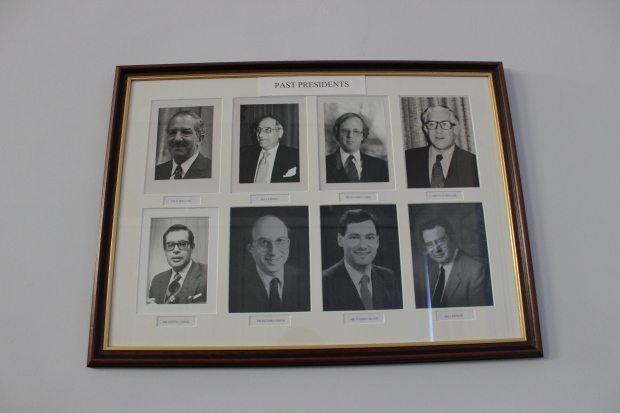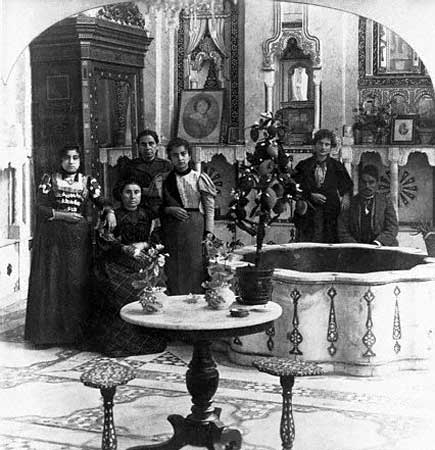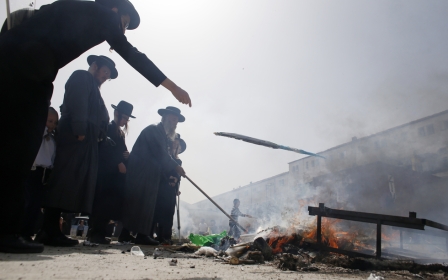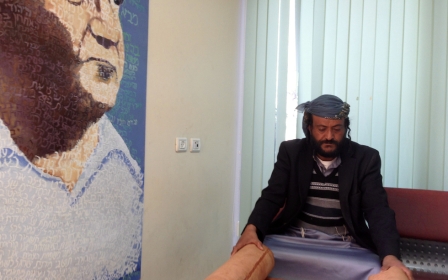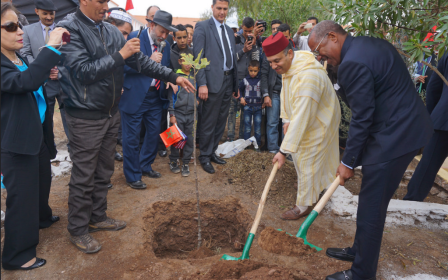The disappearing migration routes that brought Aleppo's Jews to Manchester
Abraham Batis is said to be the first Syrian Jewish trader to make it from Syria to Manchester, arriving in the northern British town in 1843. Batis was originally from Kilis, now on the Turkish side of the frontier with Syria. In recent months, the border town has treated war wounded, hosted thousands of refugees and suffered cross-border fighting.
More than 150 years on from Batis’s voyage, this town also served as the final escape route for Aleppo’s last Jewish family, who were reportedly smuggled out of Syria and into Turkey with the help of an Israeli-American businessman and moderate rebels from the Free Syrian Army late last year.
That crossing effectively ended 3,000 years of Aleppan Jewish history - another element of Syria’s uniquely multi-ethnic, diverse history lost to war.
But the UK - and Manchester, specifically - retains its own place in the history of the Syrian Jewish diaspora, one with parallels to the modern-day migration flows arriving on Europe’s shores.
Down leafy streets and Georgian terraces with bourgeois English gardens and driveways, it’s not immediately clear that Didsbury in south Manchester was, until last century, a hub for immigrants from around the Middle East.
In the so-called "millet of Manchester," historian Fred Halliday wrote in the 1990s, food was one way multiple cultures mixed: “Kibbe and mujadarra on Saturday, English roast and apple pie and milk pudding on Sunday.” Even up until after the Second World War, it was common to hear Arabic spoken in the streets of Didsbury.
Tucked down a residential side street is the Shaare Hayim Synagogue, a solemn-looking, 900-capacity temple that first opened in 1927 and later became a hub for descendants of the many “oriental Jews” who moved to the UK’s industrial heartland between the mid-19th and early 20th century.
South Manchester was already home to Sephardic Jews, descendants of Jewish families originally expelled from Spain and Portugal in the 1400s. But they were later joined by Mizrahi (Arab) Jews from the Middle East.
Many of them, like Batis, came from Syria in the hope of establishing themselves in the heart of the UK’s industrial revolution.
Today at Shaare Hayim, Jews with origins in Egypt, Iraq, Lebanon, Yemen and - since the late 20th century - Iran sing and pray alongside the descendants of Syrian migrants. During the 1990s, the community amalgamated a series of mostly Syrian breakaway synagogues, whose congregations hadn’t thought much of the austere ceremonies presided over by Spanish and Portuguese Jewish immigrants.
These Sephardhim might have turned up in top hats, while Syrian and other Arab Jews went in for less formal ceremonies. There was more singing, for one thing. It was a trend extended to the majority-Syrian Shaare Sedek synagogue, a breakaway prayer house that is now out of use.
Framed photographs of former rabbis inside Shaare Hayim’s main hall reveal roots in Egypt, Iraq and Syria. These days, the congregation is led by Rabbi Emir Ellituv, whose family origins reach into both Russia and Morocco. He explains why Syrian Jews originally came to Manchester in the 19th century.
“This way, they had all links around the world,” he adds. “That’s essentially how they would do business.”
Back then, the main reason for Syrian Jewish migration was not conflict, repression or persecution, but trade.
“These weren’t people coming with nothing,” says Lydia Collins, author of Sephardhim of Manchester: Pedigrees and Pioneers (2006), a landmark study of the city’s Jewish community.
“They weren’t coming as refugees, and they weren’t even necessarily coming with the intention of staying. They were traders, like business agents, working for people back home.”
‘Next year in Manchester’
“My grandmother was a Farhi — one of the eminent families in Aleppo and Damascus,” Dewek remembers. In fact, Dewek’s family were eminent enough to take high-ranking positions in the Ottoman administration in Syria, heading the Damascene province treasury from the 18th century onwards.
"Their biggest claim to fame was that they owned the Farhi Bible,” he says, a bible manuscript produced in medieval France between 1366 and 1383, which temporarily belonged to the family until the execution of Dewek’s ancestor, Haim Farhi. The text was later returned to the family during the lifetime of Dewek's grandmother and then sold on in the early 1900s. Nowadays, it lives in a vault in Geneva.
“Aleppo was once the centre of the textiles world, and a lot of Jews…emigrated to Syria,” Dewek recounts. “But, far from being the haven that it’s supposed to be, Syria was quite a run-down, dusty and decrepit place by the end, and a lot of the prominent Jews had already gone.”
The migration route became so established amongst Aleppo’s Syrian Jewish community that, according to Dewek, “Jews used to say Ha shana ba’a b’Manchester [‘Next year in Manchester’],” an altered version of the phrase incanted around Jewish holidays, "next year in Jerusalem".
One Sephardic history of the British city similarly claims that when a son of a Jewish trader was born in Aleppo, the words “May he live in Manchester” would be added to the traditional blessings.
“They thought that Manchester had gold-paved streets, that people could come here and make a fortune,” Dewek says. “And some of them did.”
Paving the path
Aleppo’s Syrian Jews, in migrating to cities like Manchester, were following trading routes. But people like Batis were also pioneering a migration chain across the Mediterranean that subsequent generations would follow.
But today, Marlou Schrover, an expert in migration history at Leiden University in The Netherlands, says that the type of migration that brought Aleppo’s Jews to Manchester has “basically disappeared".
“Going back to antiquity, you have these long-distance migrations of Jewish traders…who go all the way to India and very far into Africa. They have trade routes, networks and connections,” Schrover said, summarising a route like the one Dewek’s family took: Calcutta-Syria-Manchester.
“But when we hit the [economic] crisis of the 1980s, countries became much more restrictive,” Schroder added, referring to growing migration towards the end of the 20th century, followed by the 1985 Schengen Agreement.
As a result, opportunities for people from outside the EU to come and work have been reduced, with "labour migration" coming more in the form of sponsorship programmes - or only for people who are “wealthy enough,” Schrover said.
“If you want to set up a business, that is still possible - it’s not that it’s completely closed off - only that it’s not the same type of migration as during the 19th century, when people who didn’t have money or didn’t have connections would just try [to migrate] and build up this network.”
Plans by European countries to deport tens of thousands of rejected asylum seekers and economic migrants, as well as the hugely controversial EU-Turkey deal, show just how much Europe’s concept of migration has changed. Language has turned against “migrants,” creating a binary in the minds of many in Europe between deserving refugees and undeserving migrants. Migration itself has often become a source of suspicion, a security threat, a concerned talking-point on TV debate. But for Joe Dewek’s family it was more a way of life.
“I think my family would have considered themselves migrants,” Dewek says. “They came here, but they always thought next year, they’d be in New York. All their lives, they were ready to move.”
Today, there is just one Aleppo-born member of Shaare Hayim’s congregation left in south Manchester. Many have moved on elsewhere: mostly New York and Latin America, and a smaller number to Israel. Rabbi Ellituv says that assimilation has also made an impact on the community. Mother tongues are rarely used; traditional family businesses abandoned.
“Because they're two generations removed from the original immigrants, you don’t have people who view themselves as Iraqi or Syrian anymore. Unlike in the 1920s…they don’t speak Arabic. Those who are originally Syrian will only curse in Arabic,” he smiles.
There are plans to move the community to a multi-million pound development area not far from here - something that Rabbi Ellituv hopes will reinvigorate the community.
Dewek, on the other hand, believes that the community is already fading away.
“When I used to go to Shaare Hayim, the ‘big synagogue’ as we called it, it was packed to the gunnels,” he remembers. “Now of course it’s virtually empty. People moved away. And the community now is in almost terminal decline.”
New MEE newsletter: Jerusalem Dispatch
Sign up to get the latest insights and analysis on Israel-Palestine, alongside Turkey Unpacked and other MEE newsletters
Middle East Eye delivers independent and unrivalled coverage and analysis of the Middle East, North Africa and beyond. To learn more about republishing this content and the associated fees, please fill out this form. More about MEE can be found here.


